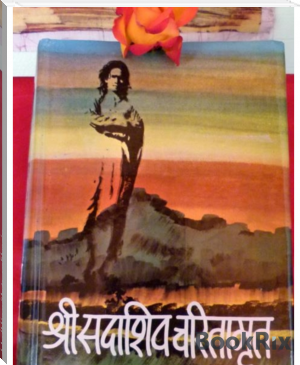Martin Luther King Jr. Day Anthology by - (children's ebooks free online TXT) 📖

- Author: -
- Performer: -
Book online «Martin Luther King Jr. Day Anthology by - (children's ebooks free online TXT) 📖». Author -
If the position of a white officer is a difficult one, that of the colored officer is still more so. He has not the self-assumed superiority of the white man, naturally feels that he is on trial, and must worry himself incessantly about his relations to his white comrades of the shoulder straps. While the United States Navy has hitherto been closed to negroes who aspire to be officers, the army has pursued a wiser and more just policy. The contrast between the two services is really remarkable. On almost every war vessel white and black sailors sleep and live together in crowded quarters without protest or friction. But the negro naval officer is kept out of the service by hook or by crook for the avowed reason that the cramped quarters of the wardroom would make association with him intolerable. In the army, on the other hand, the experiment of mixed regiments has never been tried. A good colored soldier can nevertheless obtain a commission by going through West Point, or by rising from the ranks, or by being appointed directly from civil life.
Since the foundation of the Military Academy there have been eighteen colored boys appointed to West Point, of whom fifteen failed in their preliminary examinations, or were discharged after entering because of deficiency in studies. Three were graduated and commissioned as second lieutenants of cavalry, Henry Ossian Flipper, John Hanks Alexander, and Charles Young. Of these, Lieutenant Flipper was dismissed June 30, 1882, for “conduct unbecoming an officer and a gentleman.” The other two proved themselves excellent officers, notably Young, who is at this writing a captain, and a most efficient one, in the Ninth Cavalry, with which he recently served in the Philippines. Lieutenant Alexander died suddenly in 1894. In announcing his death in a regimental order his colonel spoke of him in terms of high praise, and did not use the customary stereotyped phrases of regret. His fellow white officers all had good words for him. There never was more striking testimony to the discipline and spirit of fairness at West Point than was afforded by the sight of Cadet Charles Young, who is of very dark complexion, commanding white cadets.
Nothing else has impressed foreign visitors at West Point half so much.
An equally remarkable happening, and one which speaks even more for the democratic spirit in the army, was the commissioning in 1901 of Sergeant-Major Benjamin O. Davis, Ninth Cavalry, and of Corporal John E. Green, Twenty-fourth Infantry. Both these men were examined by boards of white officers, who might easily have excluded them because of color prejudice, in which case there would have been no appeal from their findings. Lieutenant Davis’s former troop commander, a West Pointer, openly rejoiced at his success, and predicted that he would make an excellent officer.
These are the first two colored men to rise from the ranks, but there will be many more if the same admirable spirit of fair play continues to rule in the army and is not altered by outside prejudice. It was thought that there would be a severe strain upon discipline when a colored officer rose to the rank of captain and to the command of white officers. But in Captain Young’s case his white subordinates seem to have realized that it is the position and rank that they are compelled to salute and obey, and not the individual. This principle is at the bottom of all discipline. Only too frequently do subordinates throughout the army have to remind themselves of this when obeying men for whose social qualities and character they have neither regard nor respect. During the war with Spain Captain Young commanded a negro battalion from Ohio, which was pronounced the best drilled organization in the large army assembled at Camp Alger near Washington. In addition to these officers, Captain John R. Lynch, formerly a Congressman from Mississippi, and four colored chaplains represent their race on the commissioned rolls of the army. All of these men are doing well. One colored chaplain was dismissed for drunkenness in 1894. Beyond this their record is unblemished.
Despite the fairness shown in these appointments, there has been considerable very just criticism of the War Department for its failure to appoint to the regulars any of the colored officers who did well in the Forty-eighth and Forty-ninth Volunteers. Every colonel of volunteers was allowed to designate for examination for appointment to the regular army the best officers in his regiment.
Hundreds of white officers were selected in this way, but not a single colored officer was given an examination,—not even Lieutenant McBryar, with his medal of honor, or Captain Baker.
Similarly fault has been found with Secretary Root because no new colored regiments were established under the law of February 2, 1901, increasing the army by five regiments of infantry, five of cavalry, and a large number of companies of artillery. The excuse most often heard is that the negroes already have sufficient representation in comparison with the percentage of negroes to white persons within the borders of the United States. But the sterling characteristics of the colored soldiers, their loyalty to the service as shown by the statistics of desertion, and, above all, their splendid service in Cuba, should have entitled them to additional organizations. To say the least, the decision of the War Department smacks considerably of ingratitude. Nevertheless, the negro regiments have come to stay, both in the regulars and in the volunteers. The hostilities of the last five years have dispelled any doubt which may have existed upon this point.
BAXTER’S PROCRUSTES
by Charles W. Chesnutt
Baxter’s Procrustes is one of the publications of the Bodleian Club. The Bodleian Club is composed of gentlemen of culture, who are interested in books and book-collecting. It was named, very obviously, after the famous library of the same name, and not only became in our city a sort of shrine for local worshipers of fine bindings and rare editions, but was visited occasionally by pilgrims from afar. The Bodleian has entertained Mark Twain, Joseph Jefferson, and other literary and histrionic celebrities.
It possesses quite a collection of personal mementos of distinguished authors, among them a paperweight which once belonged to Goethe, a lead pencil used by Emerson, an autograph letter of Matthew Arnold, and a chip from a tree felled by Mr.
Gladstone. Its library contains a number of rare books, including a fine collection on chess, of which game several of the members are enthusiastic devotees.
The activities of the club are not, however, confined entirely to books. We have a very handsome clubhouse, and much taste and discrimination have been exercised in its adornment. There are many good paintings, including portraits of the various presidents of the club, which adorn the entrance hall. After books, perhaps the most distinctive feature of the club is our collection of pipes. In a large rack in the smoking-room—really a superfluity, since smoking is permitted all over the house—is as complete an assortment of pipes as perhaps exists in the civilized world.
Indeed, it is an unwritten rule of the club that no one is eligible for membership who cannot produce a new variety of pipe, which is filed with his application for membership, and, if he passes, deposited with the club collection, he, however, retaining the title in himself. Once a year, upon the anniversary of the death of Sir Walter Raleigh, who it will be remembered, first introduced tobacco into England, the full membership of the club, as a rule, turns out. A large supply of the very best smoking mixture is laid in. At nine o’clock sharp each member takes his pipe from the rack, fills it with tobacco, and then the whole club, with the president at the head, all smoking furiously, march in solemn procession from room to room, upstairs and downstairs, making the tour of the clubhouse and returning to the smoking-room. The president then delivers an address, and each member is called upon to say something, either by way of a quotation or an original sentiment, in praise of the virtues of nicotine. This ceremony—facetiously known as “hitting the pipe”—being thus concluded, the membership pipes are carefully cleaned out and replaced in the club rack.
As I have said, however, the raison d’etre of the club, and the feature upon which its fame chiefly rests, is its collection of rare books, and of these by far the most interesting are its own publications. Even its catalogues are works of art, published in numbered editions, and sought by libraries and book-collectors.
Early in its history it began the occasional publication of books which should meet the club standard,—books in which emphasis should be laid upon the qualities that make a book valuable in the eyes of collectors. Of these, age could not, of course, be imparted, but in the matter of fine and curious bindings, of hand-made linen papers, of uncut or deckle edges, of wide margins and limited editions, the club could control its own publications.
The matter of contents was, it must be confessed, a less important consideration. At first it was felt by the publishing committee that nothing but the finest products of the human mind should be selected for enshrinement in the beautiful volumes which the club should issue. The length of the work was an important consideration,—long things were not compatible with wide margins and graceful slenderness. For instance, we brought out Coleridge’s Ancient Mariner, an essay by Emerson, and another by Thoreau. Our Rubaiyat of Omar Khayyam was Heron-Allen’s translation of the original MS in the Bodleian Library at Oxford, which, though less poetical than FitzGerald’s, was not so common.
Several years ago we began to publish the works of our own members. Bascom’s Essay on Pipes was a very creditable performance. It was published in a limited edition of one hundred copies, and since it had not previously appeared elsewhere and was copyrighted by the club, it was sufficiently rare to be valuable for that reason. The second publication of local origin was Baxter’s Procrustes.
I have omitted to say that once or twice a year, at a meeting of which notice has been given, an auction is held at the Bodleian.
The members of the club send in their duplicate copies, or books they for any reason wish to dispose of, which are auctioned off to the highest bidder. At these sales, which are well attended, the club’s publications have of recent years formed the leading feature. Three years ago, number three of Bascom’s Essay on Pipes sold for fifteen dollars;—the original cost of publication was one dollar and seventy-five cents. Later in the evening an uncut copy of the same brought thirty dollars. At the next auction the price of the cut copy was run up to twenty-five dollars, while the uncut copy was knocked down at seventy-five dollars. The club had always appreciated the value of uncut copies, but this financial indorsement enhanced their desirability immensely. This rise in the Essay on Pipes was not without a sympathetic effect upon all the club publications. The Emerson essay rose from three dollars to seventeen, and the Thoreau, being by an author less widely read, and, by his own confession commercially unsuccessful, brought a somewhat higher figure. The prices, thus inflated, were not permitted to come down appreciably. Since every member of the club possessed one or more of these valuable editions, they were all manifestly interested in keeping up the price. The publication, however, which brought the highest prices, and, but for the sober second thought, might have wrecked the whole system, was Baxter’s Procrustes.
Baxter was, perhaps, the most scholarly member of the club. A graduate of Harvard, he had traveled extensively, had read widely, and while not so enthusiastic a collector as some of us, possessed as fine a private library as any





Comments (0)